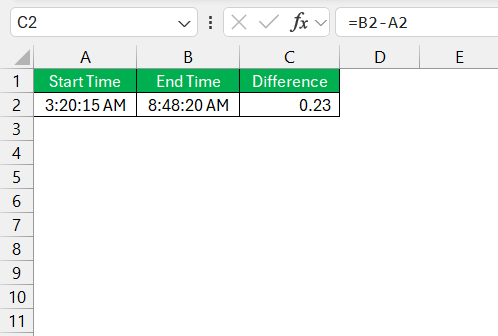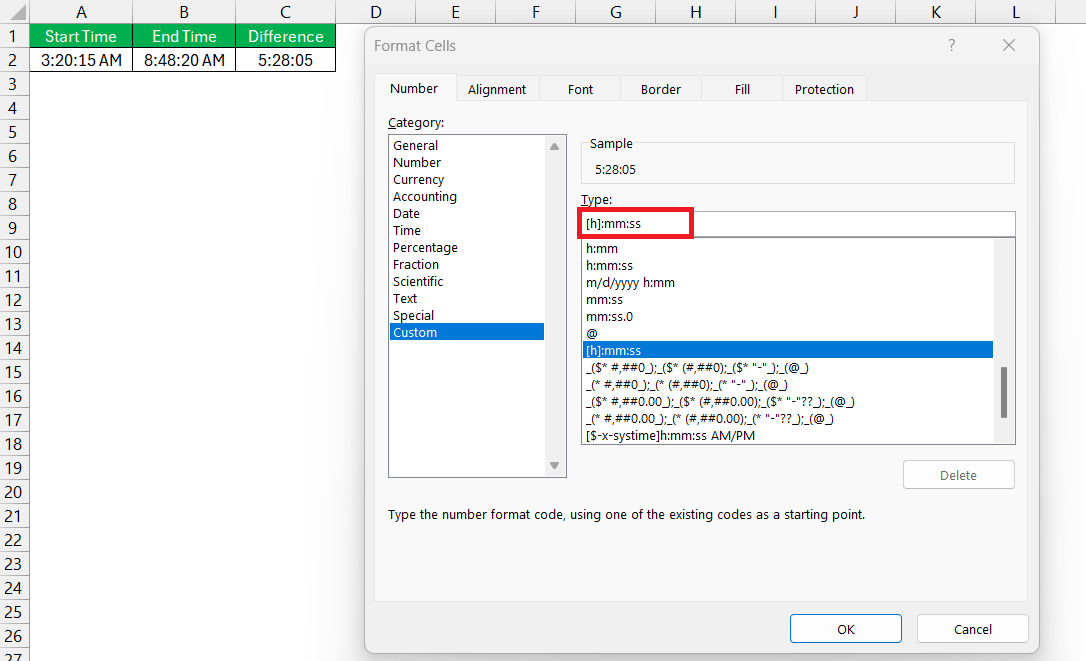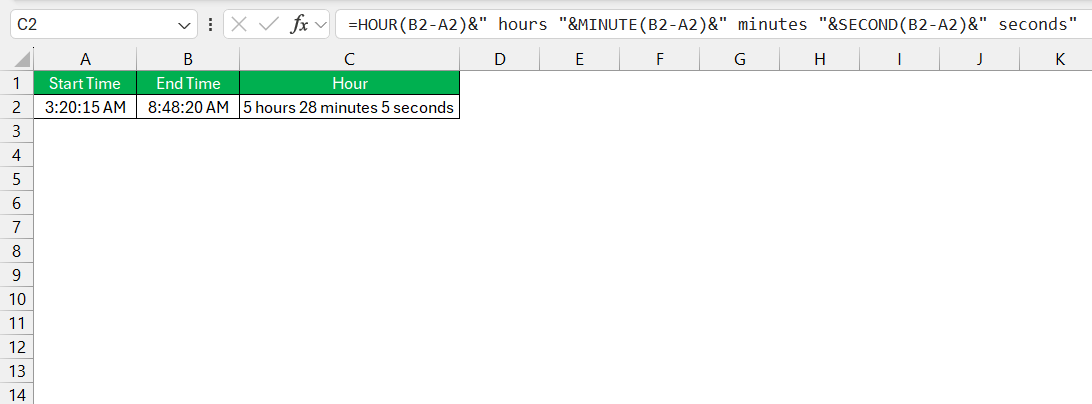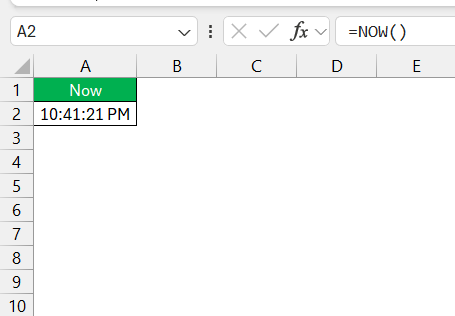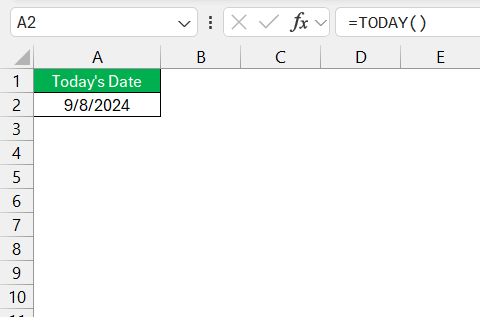Calculating the time between two timestamps in Excel is a common task that can be useful in various scenarios, from project management to time tracking. Whether you’re trying to measure the duration of a task or analyze the time spent on different activities, Excel offers straightforward methods to perform these calculations. In this article, I’ll walk you through the process of calculating time intervals between two timestamps in Excel, using both basic and advanced techniques.
Key Takeaways:
- Accurate Time Tracking is Crucial: Precise time tracking underpins efficient workflow and collaboration, especially in global projects or when working across different time zones.
- Excel Simplifies Time Calculations: Excel treats dates and times as serial numbers, allowing easy arithmetic to find the difference between timestamps, even across midnight or multiple days.
- Basic Calculation Methods: Subtracting two timestamp cells gives the interval. Format the result with
[h]:mm:ssto show the duration in hours, minutes, and seconds. - Advanced Techniques for Time Zones: Use functions like
TIME,NOW, andTODAYfor real-time data and handle multiple time zones by adjusting time zone offsets and using conditional formatting for shift management. - Efficient Time Calculations: Subtract start times from end times and format the result appropriately. For elapsed time, use functions like
MODfor spanning days andNETWORKDAYSto exclude weekends.
Table of Contents
Unlocking the Magic of Time with Excel
The Importance of Accurate Time Tracking
In our digitally intertwined world, accurate time tracking isn’t just about punctuality—it’s the bedrock of efficient workflow and collaboration. Consider the freelancer juggling clients from various time zones or the remote team coordinating a global project.
For them, understanding time differences is crucial for synchronous communication and meeting deadlines.
How Excel Simplifies Time Between Timestamps
Excel’s power to simplify time calculations lies in its ability to treat dates and times as serial numbers. This functionality lets us perform straightforward arithmetic to find the difference between two timestamps.
The beauty of this approach is that it seamlessly handles scenarios where the time stretches past midnight or even spans multiple days. With just a few clicks, one can have the duration expressed in hours, minutes, and even seconds without cumbersome manual computation. This inherent simplicity is a true game changer, turning what used to be a complex task into a trouble-free procedure.
Calculate Time Between Two Timestamps
Subtracting Two Time Cells for Interval Duration
To measure the duration between two timestamps in Excel, subtracting one cell with the start time from another with the end time gives us the interval. Say we want to know how long a meeting lasted. We’d simply input the start time in one cell, the end time in another, and use a formula to subtract the former from the latter.
This subtraction is the first step toward unlocking the duration information stored between those two points in time.
After the initial calculation, Excel may display the result as a decimal number or a date. To display the result as a time duration, you need to format the cell C2. Right-click the cell, select Format Cells, choose the Custom category, and enter the following format:
[h]:mm:ss
This format will display the total hours, minutes, and seconds between the two timestamps.
Calculating Time Difference in Hours and Minutes
To calculate the time difference between two timestamps in Excel and get the result specifically in hours, minutes, and seconds, you can use a combination of Excel’s HOUR, MINUTE, and SECOND functions. Here’s how to do it:
=HOUR(B2-A2)&” hours “&MINUTE(B2-A2)&” minutes “&SECOND(B2-A2)&” seconds”
This approach is useful when you need a clear, human-readable format for time differences, particularly in reports or logs where precise time breakdowns are required.
Advanced Excel Techniques for Time Tracking
Handling Multiple Time Zones and Shifts
Handling multiple time zones and shifts becomes a reality for many of us working in global teams or serving international clients. Excel allows me to deftly manage these differences by employing a combination of time zone conversion functions and careful scheduling. When I need to coordinate across time zones, I use the TIME function to add or subtract the time zone offset from my base time.
I can create a table with the standard working hours for each time zone I work with and use this as a template to plan meetings and deadlines. This way, I guarantee that I’m respecting everyone’s local working hours.
For shifts, Excel enables the use of conditional formatting to highlight different shift hours, making schedule overviews instantly visually understandable. By using simple addition or subtraction and mixing it with logical functions like “IF,” I can also include the calculation of shift differentials or overtime when tracking work across various time zones or shift times. The end result is a comprehensive timetable that respects global collaborators’ time constraints, optimizes productivity, and maintains team harmony.
TIME, NOW, and TODAY: Capturing Moments Instantly
Excel’s TIME, NOW, and TODAY functions are essential for capturing precise moments in my data analysis and time tracking. The TIME function allows me to create a time value explicitly from hour, minute, and second components—ideal when I need to set specific times for appointments or deadlines within my worksheet.
The NOW function is incredibly powerful, providing the exact current date and time each time my Excel sheet recalculates. It’s dynamic, meaning it updates automatically without prompting, making it indispensable for real-time data analysis and time-stamped records.
On the other hand, TODAY gives me the current date, with no time component, refreshed daily. It’s perfect when I’m focused strictly on date-related calculations, like aging reports or deadlines that don’t need hour-by-hour precision.
With these functions in my Excel toolkit, I capture and manipulate moments with impressive flexibility. This goes a long way in keeping data up-to-date and making certain that time-sensitive decisions are informed by the latest possible information.
Frequently Asked Questions (FAQ)
What’s the Most Efficient Way to Calculate Elapsed Time?
The most efficient way to calculate elapsed time in Excel is to subtract the start time from the end time in your time cells and format the result appropriately. Use simple subtraction for the same day or the MOD function for differences that span over midnight to avoid negative values. Remember to format your result cells to display time duration, ensuring hours are totaled correctly, even over 24 hours. This straightforward method provides quick and accurate results.
Can I Calculate the Time Between Dates Excluding Weekends?
Yes, you can calculate the time between dates excluding weekends using the NETWORKDAYS function in Excel. It automatically omits Saturdays and Sundays from the date range. You can also exclude specific holidays by adding them as an optional third argument to the function, further refining your time calculations to account only for the workdays relevant to your context.
How to calculate time between two timestamps in Excel?
To calculate time between two timestamps in Excel, subtract the starting timestamp from the ending one. Ensure both cells are formatted correctly with date and time. You can then format the result to display the difference as a number of days, hours, minutes, or seconds, depending on your needs. Use functions like INT and MOD for a clean representation if your calculation spans over multiple days.
How do you calculate hours between two timestamps?
To calculate hours between two timestamps, subtract the start time from the end time in Excel. Format both timestamp cells to ‘Time’ and the result cell where the difference will be shown, typically also to ‘Time’ or ‘Custom’ with [h]:mm if you want to display total hours beyond 24. Use the MOD function if the times cross midnight to prevent negative results. This approach will give you the hours and minutes between the two timestamps.
How to format as time in Excel?
To format as time in Excel, right-click the cell you want to format and select ‘Format Cells.’ In the Format Cells dialog, choose ‘Time’ from the category list. You will see different time formats, including those with hour, minute, and second options. Select the one that fits your data, such as ’13:30:55′ for a 24-hour format. Click ‘OK’ to apply your selection, and Excel will display the cell’s contents as time. For extended durations over 24 hours, use the custom format ‘[h]:mm’.
John Michaloudis is a former accountant and finance analyst at General Electric, a Microsoft MVP since 2020, an Amazon #1 bestselling author of 4 Microsoft Excel books and teacher of Microsoft Excel & Office over at his flagship MyExcelOnline Academy Online Course.

